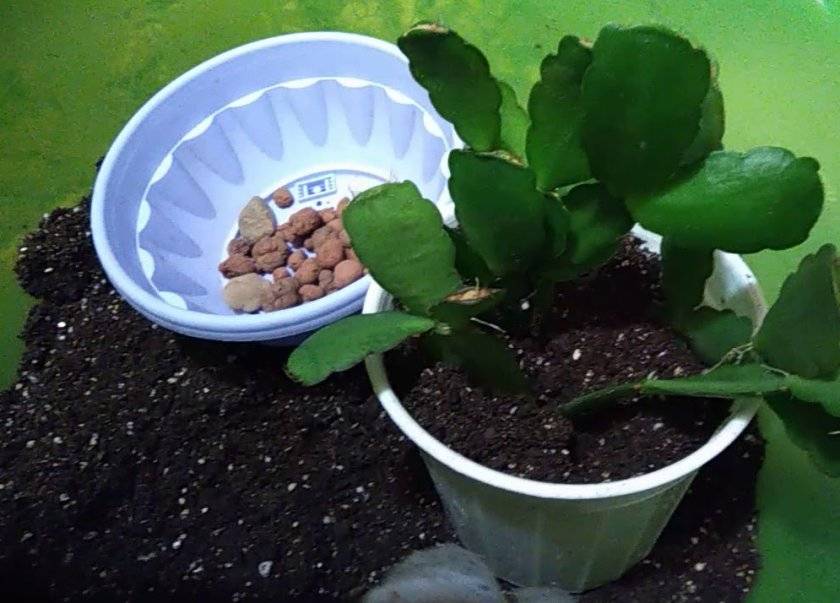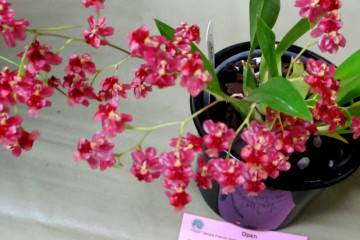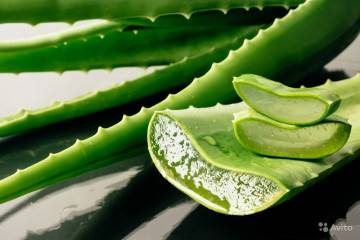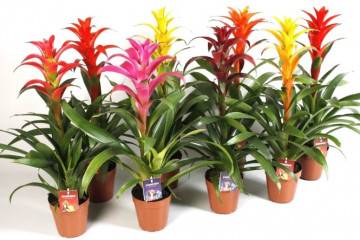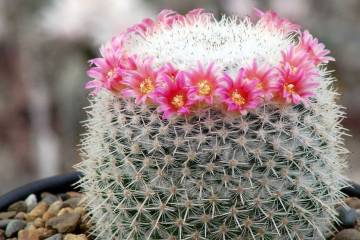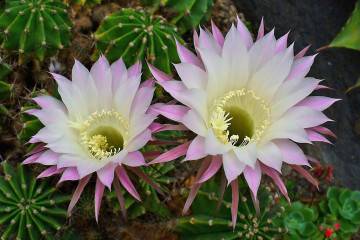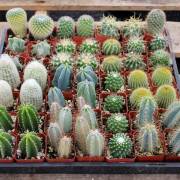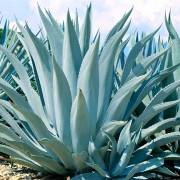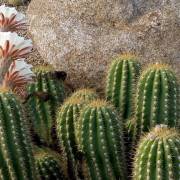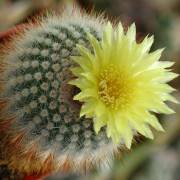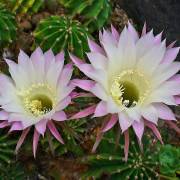Rhipsalidopsis: home care and plant varieties
Content:
The name of the cactus Ripsalidopsis, translated from Latin, sounds like "whip-like cactus with berries." Its flowering dates are in the spring, often falling on Easter, hence the popular name - "Easter cactus".
The main types and varieties of Ripsalidopsis
Classic cacti are associated with sand, a desert place. However, the habitat of Ripsalidopsis is tropical forests. Rhipsalidopsis, living in comfortable conditions all year round, has lost its thorns, dense skin, but acquired long stems-plates.
Two types of Ripsalidopsis are suitable for home cultivation: Gartner and Ripsalidopsis pink.
Rhipsalidopsis Gartner
Rhipsalidopsis Gartner resembles a low bush up to 20-25 cm high. Its flattened stems with wavy edges consist of segments of 5-6 cm each. Dangling narrow stems of several oval segments allow the plant to grow in an ampel way.
Ripsalidopsis flower forms at the end of the shoot, where areoles with dense bristles are located. 1-3 buds appear from one areola. Flowering lasts 2 months, and each individual bud lives for 2-3 days.
Different varieties of Ripsalidopsis Gartner give a wide range of colors and shades of petals:
- Varieties Capella, Flash are distinguished by pink flowers of varying degrees of saturation.
- Ripsalidopsis varieties Elisa, Ian, Leach, Evita are represented by red flowers in a wide range.
- The varieties Nina, Phoenix, Savannach have various shades of purple.
Ripsalidopsis of a cheerful orange color - the Aurigia orange variety, is in favor. The orange color in the middle is present in the Andromedia variety, in the King's Dream variety, an orange border frames the pink petals.
Ripsalidopsis fruits are pentahedral light red berries.
Rhipsalidopsis pink
Rhipsalidopsis pink is a low bush up to 15 cm in height, for which it is sometimes called dwarf. The species branches well. Stem plates are shorter than those of Gartner's, flat or with slightly pronounced ribbing.
The flower up to 5 cm in size has a beautiful pink tint and is decorated with bright golden stamens. Petals with a sharp tip are slightly curved downward.
The cactus blooms profusely, has a pleasant aroma.
Rhipsalidopsis white
Based on Gartner's Ripsalidopsis, several hybrids with different petal colors were obtained.
Ripsalidopsis white of the following varieties looks attractive:
- Sirius - snow-white star-shaped flowers bloom in unison from April to May.
- White magic - boiling white flowers bloom on a dense, fleshy segment. Abundant flowering begins in March and ends in June.
The height of the bushes barely reaches 30 cm. You can admire 10-12 flowers at the same time.
Ripsalidopsis care at home
Rhipsalidopsis takes care at home with gratitude and looks decorative at any time of the year. You just need to remember that in his homeland, in the tropics, it is always warm, humid and a lot of diffused sunlight.
Room temperature and lighting
A succulent plant feels comfortable at a temperature of 18-22 degrees. In the summer they look for a cool place for him, but away from the air conditioner. To relieve stress from the heat, the cactus is sprayed with standing water.
In winter, when the dormant period begins, the temperature is lowered to 12 degrees, for example, taken out onto a glazed balcony. Compliance with the temperature regime contributes to the amicable awakening of flower buds.
For full development, Ripsalidopsis needs bright, but diffused light. Under the scorching rays of the sun, the stems change color, acquiring a reddish tint. Place the cactus in the east or west side of the house or shade it with a cloth on the south window so as not to cause burns. Positioning on the north side reduces the number of buds.
During budding and flowering, you cannot touch and turn the plant: it will drop flowers. The plant also sheds the lower stem segments in low, out of season, temperature or waterlogged soil.
Soil and top dressing
Rhipsalidopsis, like the entire cactus family, requires light and loose soil with a pH level of up to 6 units. To obtain the desired substrate, leaf, sod, peat soils are mixed with sand or fine gravel in a ratio of 2: 1: 1: 2. If necessary, superphosphate is added to acidify.
Specialty cactus soil is sold in garden centers. When buying, pay attention to the acidity of the substrate.
You can also buy cactus fertilizers in flower shops. Mineral fertilizers that do not contain nitrogen are selected. Top dressing is carried out 2 times a month. During the dormant period (October-February), no fertilizing is applied.
Transplant features
One of the conditions for caring for Ripsalidopsis is regular transplantation. Young plants are transplanted every year, adults - every 3 years. The optimal period is after flowering and until September. The succulent plant should take root before the onset of the resting phase.
The pot is chosen wide and low, because the roots of the cactus are shallow. For a young bush, the volume of the new pot is slightly increased. For an adult plant, the size of the container can be left the same, some tightness for the roots will only stimulate flowering.
When transplanting, plants act according to a proven algorithm:
- The roots are freed from old soil, examined.
- If rotten or damaged roots are found, they are cut off.
- The bottom of the pot is covered with a drainage layer.
- Pour 2-4 cm of fresh substrate.
- Place the bush in a container and sprinkle it with earth.
- Place in a cool, shaded place for a week.
It is not required to take care of the plant at this time: the cactus will do without watering and feeding.
Reproduction methods at home
The cactus is so beautiful in bloom that growers are happy to propagate it. At home, reproduction of Ripsalidopsis will not cause difficulties even for beginners.
Propagation by seeds and cuttings segments is available to beginners, the third method - grafting - is used by professional growers.
Seed propagation
Seeds are independently obtained by cross-pollination with a brush of related plants. An unexpected result can be obtained if different varieties are pollinated.
The resulting ovaries grow and mature for a long time. Readiness is determined by the drying out of the fruit. For germination of seeds, a substrate is prepared from leafy soil and coarse clean sand. Seeds do not require preliminary preparation. They are planted in a greenhouse, creating a microclimate with warm air and moist soil. When sprouts appear, the greenhouse is periodically ventilated.
The seeds can be purchased at a gardening store. They retain their germination capacity for several years. Ripsalidopsis grown from seeds will bloom in 3-4 years.
Propagation by cuttings
When forming and pruning a bush, cuttings remain, which are used for reproduction.
- The stalk, consisting of 2-3 segments, is dried for 2-4 days: they just leave it in the air in the shade.
- They are placed, without dropping, on light moist soil or sphagnum moss.
- So that the stalk does not collapse, a support is created for it.
- After the roots appear, the seedling is transplanted into a permanent container.
A young bush will bloom in a year.
Reproduction by grafting
Ripsalidopsis is grafted onto the stem of a fast-growing leafy cactus - pereskii prickly. The procedure is carried out in the summer.
The stem of the peresky prickly is completely cleaned of leaves, the top is cut off. The lower part of the ripsalidopsis cut is sharpened with a knife and inserted into the split top of the stock. The vaccination site is fixed with a needle and covered with a plaster from drying out.
The graft will grow in 2 weeks, then the plaster is removed. The appearance of shoots or leaves below the grafting site is not allowed.
Even one blooming specimen of a cactus can decorate a room, but you should not be limited to it. When designing a Ripsalidopsis design, a mix of several varieties or varieties is only welcomed: the flowering period of the composition increases without affecting the well-being of each bush.


